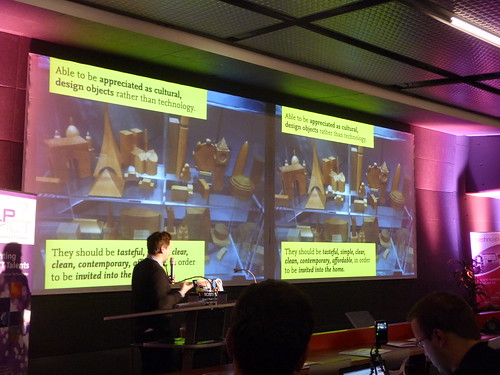Two week ago at the the "New Digital Spaces conference at Technoark in Sierre, Switzerland, Matt Jones gave a talk called "people are walking architecture". You can see the video here.
 (Fabien's picture of Matt Jones at Technoark)
(Fabien's picture of Matt Jones at Technoark)
In his presentation, he introduced the notion of "Mujicomp", a portmanteau word made of "Muji" (the japanese retail company which sells a wide variety of household and consumer goods) and "Computing". What does it mean?
According to Jones, the idea of "mujicomp" revolved around the notion that ubiquitous computing needs to "become sexy and desirable... able to be appreciated as cultural design objects rather than technology... they should be tasteful, simple, clear, clean, contemporary, affordable in order to be invited into the home". If designers and engineers want to "make smart cities bottom up with products and not academic ubiquitous computing which are always postponed", he argued that ubicomp will need some "muji". And of course, as shown by Jone's use of the quote from Eliel Saarinen, "always design a thing by considering it in its larger context... a chair in a room, a room in a house, a house in an environment".
Starting from the ground-up can lead to some "almost mujicomp" products he mentioned ranges from energy monitor (Watsson, Wattcher) to more curious devices such as Availabot or Olinda that they develop at BERG. The fon phone is also an example here.
As computing requires not only artifacts but also infrastructures, there's a need for "mujicompfrastructures":
"could you create infrastructures with desirable things? the importance of threshold: how could we look at the spaces where we used our devices in a same way architect look at things? like bottom-up urbanism? different elements/gray shades between the private and the public: street, sidewalk, pavement, porch, home this connects to jane jacobs: intervening is not just about creating big infrastructures but sidewalk-scale system that could leak out into the home"
Also in his presentation, Matt talked about the "patchy homebrew equivalent of the nearly-net that would work", relying on Clay Shirky's Permanet, Nearlynet, and Wireless Data:
"Call the first network "perma-net," a world where connectivity is like air, where anyone can send or receive data anytime anywhere. Call the second network "nearly-net", an archipelago of connectivity in an ocean of disconnection. Everyone wants permanet -- the providers want to provide it, the customers want to use it, and every few years, someone announces that they are going to build some version of it. The lesson of in-flight phones is that nearlynet is better aligned with the technological, economic, and social forces that help networks actually get built."
Why do I blog this? took some time to sort my (messy) notes that highlight interesting aspects of ubicomp evolution and the role of designers in this.